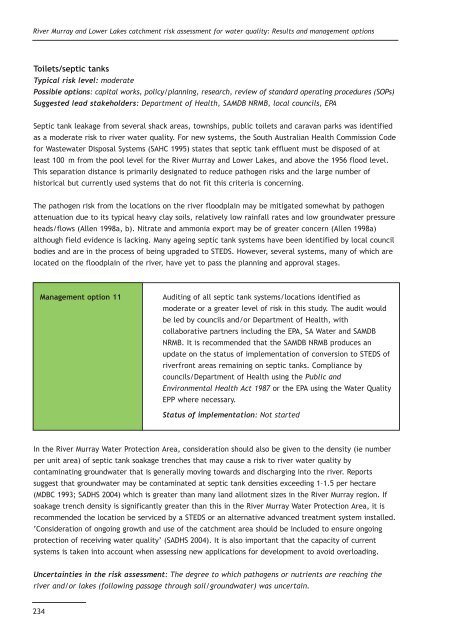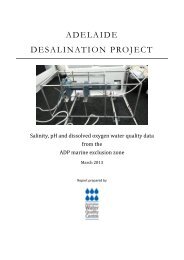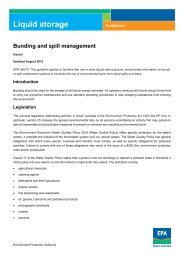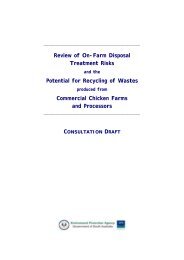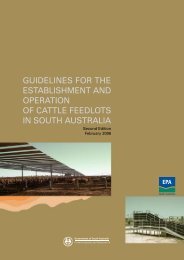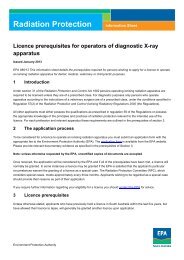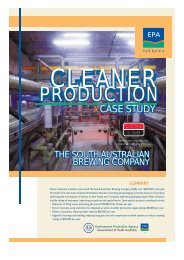2 Renmark to border LAP area assessment - EPA - Sa.gov.au
2 Renmark to border LAP area assessment - EPA - Sa.gov.au
2 Renmark to border LAP area assessment - EPA - Sa.gov.au
You also want an ePaper? Increase the reach of your titles
YUMPU automatically turns print PDFs into web optimized ePapers that Google loves.
River Murray and Lower Lakes catchment risk <strong>assessment</strong> for water quality: Results and management options<br />
Toilets/septic tanks<br />
Typical risk level: moderate<br />
Possible options: capital works, policy/planning, research, review of standard operating procedures (SOPs)<br />
Suggested lead stakeholders: Department of Health, SAMDB NRMB, local councils, <strong>EPA</strong><br />
Septic tank leakage from several shack <strong>area</strong>s, <strong>to</strong>wnships, public <strong>to</strong>ilets and caravan parks was identified<br />
as a moderate risk <strong>to</strong> river water quality. For new systems, the South Australian Health Commission Code<br />
for Wastewater Disposal Systems (SAHC 1995) states that septic tank effluent must be disposed of at<br />
least 100 m from the pool level for the River Murray and Lower Lakes, and above the 1956 flood level.<br />
This separation distance is primarily designated <strong>to</strong> reduce pathogen risks and the large number of<br />
his<strong>to</strong>rical but currently used systems that do not fit this criteria is concerning.<br />
The pathogen risk from the locations on the river floodplain may be mitigated somewhat by pathogen<br />
attenuation due <strong>to</strong> its typical heavy clay soils, relatively low rainfall rates and low groundwater pressure<br />
heads/flows (Allen 1998a, b). Nitrate and ammonia export may be of greater concern (Allen 1998a)<br />
although field evidence is lacking. Many ageing septic tank systems have been identified by local council<br />
bodies and are in the process of being upgraded <strong>to</strong> STEDS. However, several systems, many of which are<br />
located on the floodplain of the river, have yet <strong>to</strong> pass the planning and approval stages.<br />
Management option 11 Auditing of all septic tank systems/locations identified as<br />
moderate or a greater level of risk in this study. The <strong>au</strong>dit would<br />
be led by councils and/or Department of Health, with<br />
collaborative partners including the <strong>EPA</strong>, SA Water and SAMDB<br />
NRMB. It is recommended that the SAMDB NRMB produces an<br />
update on the status of implementation of conversion <strong>to</strong> STEDS of<br />
riverfront <strong>area</strong>s remaining on septic tanks. Compliance by<br />
councils/Department of Health using the Public and<br />
Environmental Health Act 1987 or the <strong>EPA</strong> using the Water Quality<br />
EPP where necessary.<br />
234<br />
Status of implementation: Not started<br />
In the River Murray Water Protection Area, consideration should also be given <strong>to</strong> the density (ie number<br />
per unit <strong>area</strong>) of septic tank soakage trenches that may c<strong>au</strong>se a risk <strong>to</strong> river water quality by<br />
contaminating groundwater that is generally moving <strong>to</strong>wards and discharging in<strong>to</strong> the river. Reports<br />
suggest that groundwater may be contaminated at septic tank densities exceeding 1–1.5 per hectare<br />
(MDBC 1993; SADHS 2004) which is greater than many land allotment sizes in the River Murray region. If<br />
soakage trench density is significantly greater than this in the River Murray Water Protection Area, it is<br />
recommended the location be serviced by a STEDS or an alternative advanced treatment system installed.<br />
‘Consideration of ongoing growth and use of the catchment <strong>area</strong> should be included <strong>to</strong> ensure ongoing<br />
protection of receiving water quality’ (SADHS 2004). It is also important that the capacity of current<br />
systems is taken in<strong>to</strong> account when assessing new applications for development <strong>to</strong> avoid overloading.<br />
Uncertainties in the risk <strong>assessment</strong>: The degree <strong>to</strong> which pathogens or nutrients are reaching the<br />
river and/or lakes (following passage through soil/groundwater) was uncertain.


